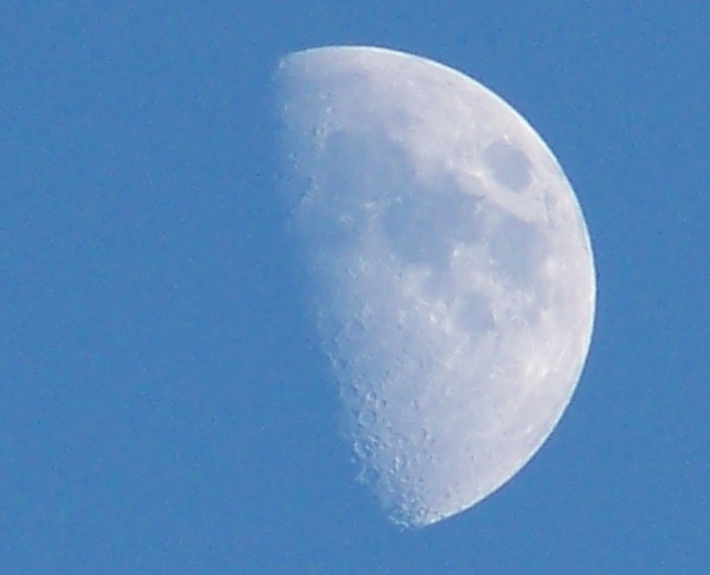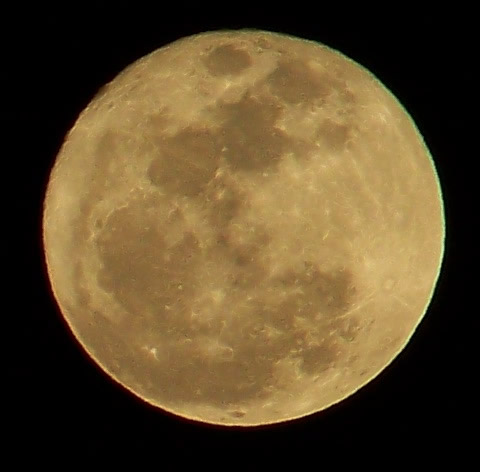Shooting the moon – Photography
One of my more recent goals in becoming a better photographer has been to capture a good picture of the moon.
This may sound easy to those of you who have never tried or to those of you who have only taken a picture of the moon in a pretty daytime blue or evening blue sky. But if you have tried to take a picture of the moon in a dark night time sky, I am sure your results looked something like this:
I started out, like I am sure many people have, trying to shoot the moon with my camera’s auto settings. Then I moved on to scene settings such as fireworks and night time landscape. Every attempt resulted in blown out bright blobs on an otherwise black (other than an occasional star or planet) background.
After trying every auto setting my camera had to offer, I realized that this is a job for those rarely used [by me] PASM marks on my dial.
After some unsuccessful trial and error, I turned to the major search engines to tell me what numbers I should be setting my apeture (f-stop), ISO, and shutter speed to. I saw some amazing images. But they were captured with more advanced cameras than mine. – What is a person without an f/16 or even f/11 capable camera to do?
I got a rough idea of what the ratios should be from the websites. Finally, a good starting point for where to set my camera! Below are some of the pictures I have taken and the settings I used. Scroll to the bottom of the pics for tips and tools.

12x zoom, Landscape scene. - Notice that the camera's auto settings can capture a nice moon pic when there is the right amount of contrast between the brightness of the moon and the bluness of the sky.
gallery
Tips:
First tip. The one that has caused me much frustration – The “perfect” settings that you find one night won’t necessarily work the next. Remember, the moon is constantly moving and changing brightness levels. (More specificallly, the earth’s atmosphere and shadow affect how much light the moon sends us.) You will have to make some minor adjustments to your setting almost every time you go a few days, or even hours between pictures.
Zoom
The moon is a huge object. But it appears far away and small in the night time sky. If you don’t have your camera hooked up to a telescope, try to use a camera with at least 10x optical zoom to capture more detail.
Also, when you are using a lot of zoom and/or a slow shutter speed, a small shake of the hand can make a big difference. Many photographers will need a tripod.
Focussing
There is a good chance you will have to explore your camera’s manual focus settings when shooting the moon.
The moon is not “to infinity and beyond”, so don’t be surprised if setting the manual focus on “infinity” does not work.
And remember what I said about how the settings you use one night probably won’t work the next? This is true when using manual focus too. One of my above pictures was achieved by setting the focus range about 3/4 of the way between close-up and infinity. A few nights later, I was about 9/10 of the way to infinity. I huge jump in my opinion!
Tools
I have not had the chance to explore this tool in depth yet. But I would like to share the calculator I found at http://www.adidap.com/2006/12/06/moon-exposure-calculator/ .
This calculator isn’t too intuitive, but maybe you can figure it out. And the numbers it gives may not match your camera’s exact capabilities. But they should help you find an approximate starting point.







Beautiful photographs and great tips, Michelle, thanks. I have also found for me the most invaluable on-camera tool is the spot-meter. I have had cameras without out it and the moon comes out like your white-blob photo, especially if you have limited manual control. The spot meter is a wonderful tool, and combined with bracketing, you are nearly guaranteed to enjoy beautiful photos of our nighttime celestial friend. My old Minolta also had a metering-lock feature so that you can meter your subject, lock it, then offset the subject (i.e. put the moon in the corner of the frame), and still have fantastic results. Not sure which non-DSLR’s have that capability now.
Looking forward to more tips!!!
If anyone’s interested, I was just checking a moonphase/distance/rise/set calculator and it looks like May 16th will be a full moon with moonrise in East Texas at right about 19:48 (7:48PM) and the moon should only be about 57.2 earth-diameters (who comes up with these measurements?) away; the closest-distance shot at a full moon until next April!
Hopefully if enough of us are out looking for shots on the evening of the 16th, one of us’ll get the right weather & camera settings to capture a pretty spectacular shot!
Happy moongazing!
Excellent 🙂 Thank you for letting us know. – I bet there will be some really nice moon against blue colors going on too that time of night.